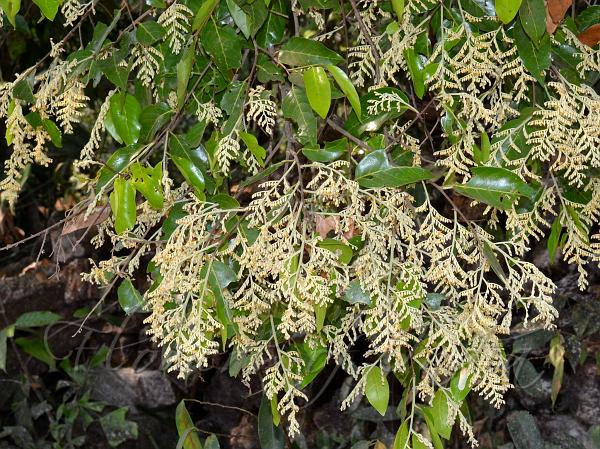|
| Malabar Ironwood |
|

|

| File size | 1032900 |
| Original date | 3/7/16 3:33 PM |
| Resolution | 2048 x 1536 |
| Flash | Flash fired, return detected |
| Focal length | 30.0mm |
| Exposure time | 1/160s |
| Aperture | 10.0 |
| Focus Distance | |
| Metering Mode | Center weighted average |
| Camera make | NIKON CORPORATION |
| Camera model | NIKON D5200 |
| Sensor type | OneChipColorArea |
|
|
|
|
Photo: |
Botanical name: Hopea parviflora Family: Dipterocarpaceae (Sal family)
Malabar Ironwood is a tree up to 35 m tall, bole
straight, buttressed, bark 6-10 mm, light brown or grey, mottled with
white, rough vertically fissured, fibrous; blaze yellowish; branchlets
reddish-brown, slightly velvet-hairy. Leaves are simple, alternate;
stipules small, lateral, deciduous; leaf-stalk 1.0-1.2 cm, slender,
velvet-hairy when young, hairless when matured, grooved above; blade
8-11.5 x 3-5 cm, ovate, lanceshaped or ovate-lanceshaped, base pointed
blunt, heart-shaped or subheart-shaped, tip pointed or hairless,
apiculate, leathery; lateral nerves 8-12 pairs, pinnate, prominent,
intercostae scalariform, faint, domatia present. Flowers are bisexual,
3-4 mm across, creamy yellow, in unilateral at branch-ends and upper in
leaf-axils, woolly racemose panicles; sepals 5, 3 mm long, woolly
outside; petals 5, 6 mm long, oblong, hairless, fringed at tip; stamens
5, rarely 10, slightly fused; connective of anthers produced into a
subulate point; ovary superior, hairless, ovules 2 in each cell; style
short, subulate. Fruit is a nut, 5-6 mm long, round, hairless; wings 2,
6 x 1.8 cm, 8-10 nerved, hairless. Wood is brown, close-grained, hard,
used extensively in house construction, for planking, as piles for
bridges, for making platform boards, agricultural implements, for
making railway sleepers and electric poles. It is also used for parts
of ships, boat building, road rammers, rice pounders, sets, ladders,
engine break blocks, railway keys, picker arms and for decorative wood
work and turnery. The bark is considered a good tanning material and
is used for tanning especially heavy quality leather.
Malabar Ironwood is endemic to Southern Western Ghats. Flowering:
January-April.
| Identification credit: Anurag Sharma | Photographed in Karkala, Karnataka. |
• Is this flower misidentified? If yes,